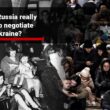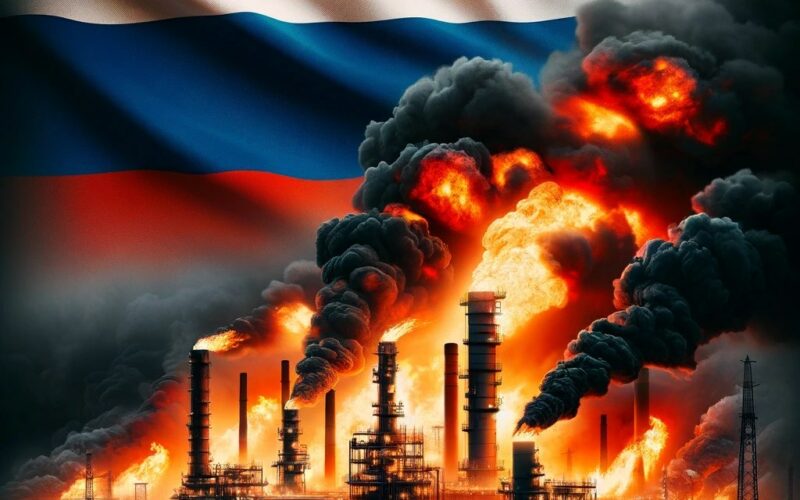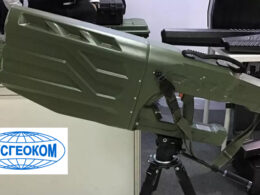At the start of 2024, Ukrainian long-range strikes on energy facilities on Russian Federation territory had sharply increased in intensity and effectiveness. Ukrainian forces targeted Russian military-industrial complex enterprises, oil refineries, infrastructure involved in the export of energy resources (ports, cargo terminals), and even metallurgical plants.
And, most interestingly, the success of these operations depended largely not only on the success of the Ukrainian aviation industry and the skill of UAV operators, but also on the sophisitacated information and psychological operation of the Ukrainian forces. But first, a brief analysis of the strikes on Russian territory.
On January 18, unknown assailants attacked an oil depot in Ust-Luga, Leningrad Region, one of the Russian Federation’s largest oil and gas infrastructure facilities on the shores of the Gulf of Finland, located almost 900 kilometers from the Ukrainian border. The attacks on the Leningrad region and St. Petersburg continued: on January 31, a drone landed on the territory of the Neva oil refinery, followed by an unsuccessful attack on March 2—the drone missed the oil depot by only a few meters.
On the night of January 25, a UAV strike caused a massive fire at the refinery in the port city of Tuapse on the Black Sea, and on January 29, it hit one of Russia’s largest refineries, Slavneft-Yanos in Yaroslavl. The Russian air defense did not work out. Ukrainian UAVs are also hitting Russian facilities at short distances from the front line.
On March 3, Ukrainian UAVs attacked an oil depot in Feodosia; on March 5, they targeted an oil depot in the Gubkinsky district of the Belgorod region; and on March 6, they struck an oil depot in Voronezh. On March 13, the Ryazan refinery suffered serious damage.
The consequences of these strikes were colossal financial losses from lost profits and, no less, enormous costs of restoring production processes. It is very important that the majority of Russian (in the past, Soviet) refineries use basic units and assemblies produced in Western countries. In Soviet times, engineers simply adjusted foreign documentation to the current GOSTs, without engaging in widespread design and creation of their own units for oil distillation and refining.
Ukrainian UAVs hit not only oil depots and refineries. On January 21, a drone attacked the Shcheglovsky Val plant in Tula, the assembly site for Pantsir-S1 air defense systems. In addition, over the past few weeks, the Armed Forces of Ukraine have launched a series of strikes against the Russian metallurgical industry.
The Ukrainians launched an attack on the Novolipetsk Iron and Steel Works, one of the largest in the Russian Federation. Its products served both the export market and the domestic civilian market. The military utilized this steel in manufacturing gun barrels and armored vehicle components.
On March 6, the Mikhailovsky mining and processing plant became a victim. The process destroyed tanks with fuel. It is located in Zheleznogorsk, Kursk region, near one of Russia’s largest iron ore deposits. On March 7, there were reports of a powerful explosion at the Severstal steel mill in Cherepovets, located 800 kilometers from the Ukrainian border. According to unconfirmed information, the drone was powerful enough to destroy one of the blast furnaces. The Russian air defenses were again inactive.
What are the reasons for the Ukrainian security services’ success? First of all, by obtaining the necessary strike capabilities in sufficient quantity. We are talking about the Bober, Lyut, Morok, and other kamikaze UAVs. Some are probably still unknown to the public. These UAVs are capable of traveling 800 kilometers or more and carry quite powerful warheads. The second key success factor is the thinness of the Russian air defense system and its inability to provide sufficiently dense coverage of the sky over the Russian Federation’s territory.
But let’s return to the Ukrainian PsyOps. Its simplicity in execution demonstrated its genius. The Ukrainians concentrated on two things.
The first factor was time. The operation stretched over time, creating a sense of disjointed, unconnected actions. The calculation was that Russian staffers would not perceive the operation’s integrity. The calculation proved to be accurate. They did not.
The second factor is that the Russians, at the suggestion of their own propagandists, declared Crimea a sacred place, a kind of “sacred cow,” which Russia will defend at all costs. The Ukrainians played on this; they were very active in fueling the Russians’ fears about Crimea, constantly talking and talking about the destruction of the Crimean bridge and striking Crimea with cruise missiles until the General Staff of the Russian Armed Forces saturated the peninsula with air defense systems to such an extent that any attempts by the Ukrainians to use means of air attack here became meaningless.
But the number of air defense systems in Russia is a finite figure, and the production of such systems is a complicated and expensive affair, and most importantly, not fast. If a lot of air defense systems have appeared in one place, it automatically means that somewhere else there are holes in the air defense umbrella. Some air defense systems guard the front, while a large number of advanced systems protect Crimea, leaving huge territories of Russia with strategic plants located on them vulnerable.
As Crimea settled into a state of calm, Ukraine celebrated the success of the operation. And began to methodically strike deep into the Russian territory on factories and plants. The Ukrainians simply transferred the hostilities in Crimea to the sea on the principle that if nothing flies, it will swim. And now they are sinking ships of the Black Sea Fleet with surface drones, against which all the wonderful Crimean air defense systems are absolutely useless.
Ukraine’s strikes on Russian oil refineries have already led to significant negative consequences for Moscow.
Thus, on March 13, 2024, experts at the Security Council of the Russian Federation provided a new report on the risks associated with the Ukrainian strikes on Russian oil refineries. According to experts’ estimates, fuel shortages will arise in the near future, which will lead to higher prices for gasoline and diesel fuel.
Higher logistics costs will spur inflation. Industry experts suggested several options to mitigate the crisis, which can be implemented by stopping the strikes on oil refining facilities. If the strikes continue, the damage increases, and Russia’s refineries are forced to stop processes and shut down for repairs, the crisis could become large-scale and poorly controlled.








